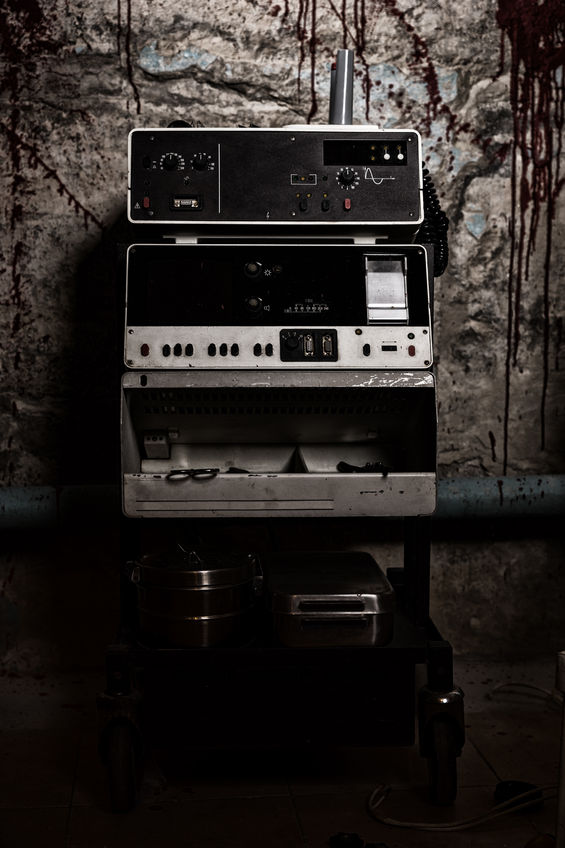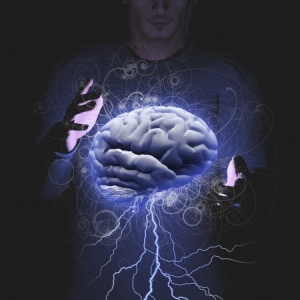To Shock or Not to Shock
To shock or not to shock; that is the question. Is electroconvulsive therapy (ECT) an effective and safe treatment for severe cases of mood disorders such as depression? Or is it something that “permanently impairs memory and causes other long term signs of mental dysfunction such as difficulties with concentration and new learning?” It continues to be one of the most controversial treatments used in medicine because “precisely why electroshock works is a mystery.” And it’s also because it has a history of being used as a form of torture and euthanasia by at least one Nazi doctor.
In October of 1939, shortly after the invention of ECT by two Italian researchers, Adolf Hitler signed a decree that authorized German doctors to euthanize any psychiatric patient who was deemed incurable. “Between 1939 and 1941, tens of thousands of patients were killed at psychiatric hospitals.” While the program officially ended in 1941, the practice continued until the defeat of Germany in 1945 particularly with Dr. Emil Gelny. After just three months of clinical training, Gelny was granted a specialist qualification in psychiatry in 1943 and placed in charge of two psychiatric hospitals in Austria. At first, he used lethal doses of drugs like morphine and barbiturates to kill ‘incurable’ patients, but when the drugs became scarce, he modified existing ECT machines.
After the initial shock rendered the patient unconscious, he added four extra electrodes and attached them to the person’s wrists and ankles to deliver the lethal shocks. In “Mass killing under the guise of ECT,” the authors wrote: “Besides its easy availability and cost-effectiveness, a further important factor was that ECT could be camouflaged as a medical procedure to reduce patients’ suspicion, at a time when many correctly feared that drugs were used to kill them.” The author of “How Electroconvulsive Therapy Became a Nazi Weapon” said it was not clear how many individuals Gelny murdered with ECT. The combined death toll at the two hospitals was 4,800, but most patients likely died from drug overdoses or malnutrition. For more information on the Nazi use of psychiatry in euthanasia, see “Psychiatry’s role in the holocaust.”
Supporters of ECT like Dr. Jeffrey Lieberman say that modern ECT technologies allow for individualized treatment for each patient so the minimum amount of electricity needed to induce a seizure is used. Allen Frances, the chair for the DSM-IV, said on Twitter that if he had severe depression, “ECT would definitely be my 1st choice.” The use of anesthetics combined with muscle relaxants and oxygenation “render ECT an extremely safe procedure,” according to Dr. Lieberman. He thought it was extremely ironic that the inventors of ECT failed to even be nominated for a Nobel Prize, “despite the fact that their invention was the only early somatic treatment to become a therapeutic mainstay of psychiatry.” He noted where the APA, NIH and FDA all approve the use of ECT “as a safe and effective treatment for patients with severe cases of depression, mania, or schizophrenia, and for patients who cannot take or do not respond to medications.”
On the other side of the ECT debate is Dr. Peter Breggin, who has been personally and professionally fighting against the use of ECT for over thirty years. You can review a wealth of information, including over 150 scientific studies by him and others, on his website: ECT Resources Center. One of his ‘key articles,’ “The FDA should test the safety of ECT machines” was written in 2010 to inform the FDA about the damaging effects of ECT as it was considering a reclassification of ECT treatment as safe for depressed patients. Breggin’s opening comment was: “Since its inception in the late 1930s, electroconvulsive therapy (ECT) has never been subjected to testing for Food and Drug Administration (FDA) approval in regard to safety and effectiveness.”
He said ECT is acknowledged, even among staunch advocates of the procedure, as the most controversial treatment in psychiatry. The Consensus Development Conference on ECT, conducted by NIH, was cited as affirming that assertion. “Given this extraordinary degree of controversy, there can be no justification for not subjecting ECT to the same scrutiny that is given to devices and treatments that are far less controversial, including at the least new animals studies.” Since it causes an acute delirium, there is no scientific doubt ECT harms the brain and mental function.
ECT produces sufficient trauma to the brain to cause a severe grand mal convulsion. All ECT treatments result in a period of coma lasting several minutes or more, sometimes including a flat line EEG. In routine application, the patient awakens in a delirium that is virtually indistinguishable from any other closed head injury. Typical symptoms include severe headache, memory dysfunction, disorientation, confusion, lack of judgment and unstable mood. The treatment always results in apathy, and sometimes in euphoria, which are typical reactions to traumatic brain injury. Consent forms routinely warn patients not to make decisions during or shortly after the completion of any series of ECT treatments.It is acknowledged in neurology that repeated head injuries that produce concussive symptoms are likely to cause persistent harm. ECT treatments are far more traumatic than most concussions, and include prolonged coma after each treatment, sometimes accompanied by EEG flat lining, and severe delirium after a few treatments or less. The number of traumatic ECT treatments usually far exceeds the number of concussions that produce lasting harm.In the rational practice of regulatory affairs, the fact that a treatment causes such initial trauma would in itself require it to be withdrawn from the market; it certainly requires a thorough examination of ECT by the FDA, starting with animal studies.
He referred to large animal studies that demonstrated generalized brain damage from ECT. He pointed to a 2007 study confirming that ECT produces lasting memory dysfunction and more generalized persistent cognitive deficits. “Except in regard to a psychiatric treatment, substantial evidence on this scale for persistent damage would lead to an inquiry into withdrawing a treatment from the market.” And despite several decades of effort, ECT advocates have not been able to demonstrate any lasting improvement.
The Consensus Development Conference on ECT found that controlled clinical trials failed to demonstrate any positive effect beyond four weeks. Thus the risk/benefit ratio is very poor. This four-week period corresponds to the period of the acute delirium, when the ECT effects of emotional blunting and/or euphoria are mistaken for clinical improvement. Typically, the patient stops voicing complaints and may display an artificially elevated mood.
The result of the hearings was a FDA advisory panel recommended in 2011 that ECT devices be designated as high risk for all patients: “FDA panel advises more testing of ‘shock-therapy’ devices.” Note the contradiction to what Dr. Lieberman claimed.
FDA staffers who reviewed hundreds of studies reported that as a group, they were poorly designed and had too few patients to allow firm conclusions to be drawn. “Many failed to follow patients long enough to discover the duration of ill effects.” The majority of the 18-member committee said not enough was known about ECT and more research was needed into the usefulness and hazards of the ECT devices.
That ruling led to an ongoing controversy, with the FDA tabling the issue until in 2015 it drafted a ‘proposed order’ that would reclassify ECT as safe and effective and only moderately risky for adults with severe depression who haven’t responded to medication or other therapies. However, it would also impose new requirements, like requiring physicians to warn patients that the side effects of ECT can include confusion and memory loss, and that its long term safety in not proven. They would also have to monitor patients’ memory and cognitive skills before and during treatment. “And the FDA would also classify ECT as high risk for psychiatric conditions other than depression and for children and adolescents.”
STAT News said psychiatrists are concerned that classifying ECT as a high risk procedure for psychiatric conditions other than depression, and for children and adolescents “could prompt insurers to stop covering and doctors to stop recommending ECT for younger patients” and those with other psychiatric conditions, like schizophrenia, bipolar mania and catatonia. It would require ECT manufacturers to conduct clinical trials for these indications. “It’s widely expected they will decline to do so because of the cost.” Doctors could still provide ECT “off label,” but insurance companies could refuse to pay. “And physicians may worry about the potential for malpractice lawsuits if anything goes wrong.”
Stop and think for a minute about these last statements. ECT device manufacturers are expected to decline to do expensive clinical trials to confirm that their device is safe and effective for patients who are children, adolescents, and suffer from psychiatric conditions other than severe depression. If there were studies provided to the FDA in 2010 to support the use of ECT to treat these populations, they were poorly designed and had too few patients to allow for conclusions to be drawn. So they have been using ECT devices to treat these populations without reliable clinical trial evidence. And apparently the doctors who do ECT want to continue doing so without worrying about “the potential for malpractice lawsuits if anything goes wrong.”
The American Psychiatric Association and the consumer group NAMI (National Alliance of Mental Illness) think the FDA should classify ECT as moderately risky for all conditions for which it is now commonly used. The FDA received 2,040 comments on its draft rule during the public comment period closed in March of 2016. “The agency has not given a timetable for issuing a final rule.”
While we await the FDA decision on its draft guidance for ECT devices, consider these comments from Peter Breggin’s “Introductory Information About ECT”:
After one, two or three ECTs, the trauma causes typical symptoms of severe head trauma or injury including headache, nausea, memory loss, disorientation, confusion, impaired judgment, loss of personality, and emotional instability. These harmful effects worsen and some become permanent as routine treatment progresses.ECT works by damaging the brain. The initial trauma can cause an artificial euphoria which ECT doctors mistakenly call an improvement. After several routine ECTs, the damaged person becomes increasingly apathetic, indifferent, unable to feel genuine emotions, and even robotic. Memory loss and confusion worsen. This helpless individual becomes unable to voice distress or complaints, and becomes docile and manageable. ECT doctors mistakenly call this an improvement but it indicates severe and disabling brain injury.Abundant evidence indicates that ECT should be banned. Because ECT destroys the ability to protest, all ECT quickly becomes involuntary and thus inherently abusive and a human rights violation. Therefore, when ECT has already been started, concerned relatives or others should immediately intervene to stop it, if necessary with an attorney.
Meanwhile, two Pennsylvania state representatives are not willing to wait and see what the FDA recommends. They introduced a bill to prohibit the use of ECT on individuals age 16 and under. The co-sponsors thought it was deplorable when ECT was done to children who have no say on whether to agree or not to the treatment. One of them said he thought it was a form of child abuse. According to the Pennsylvania Department of Human Services, 13 children under the age of 5 were given ECT in 2014. Three adolescents between 13 and 17 were electroshocked as well that year. “Children should not be forced to undergo a treatment that can have a lasting impact on their physical and mental well-being.”
Also see: “The Frankenstein Monster of ECT,” “Is ECT Brain Disabling?” and “The Appalling Silence on ECT” on this website.




